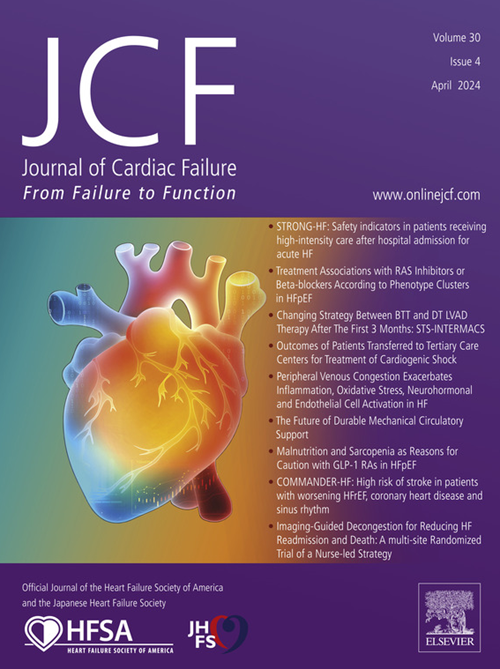A Machine Learning-derived Risk Score Improves Prediction of Outcomes After LVAD Implantation: An Analysis of the INTERMACS Database
IF 6.7
2区 医学
Q1 CARDIAC & CARDIOVASCULAR SYSTEMS
引用次数: 0
Abstract
Background
Significant variability in outcomes after left ventricular assist device (LVAD) implantation emphasize the importance of accurately assessing patients' risk before surgery. This study assesses the Machine Learning Assessment of Risk and Early Mortality in Heart Failure (MARKER-HF) mortality risk model, a machine learning-based tool using 8 clinical variables, to predict post-LVAD implantation mortality and its prognostic enhancement over the Interagency Registry of Mechanically Assisted Circulatory Support (INTERMACS) profile.
Methods
Analyzing 25,365 INTERMACS database patients (mean age 56.8 years, 78% male), 5,663 (22.3%) and 19,702 (77.7%) received HeartMate 3 and other types of LVAD, respectively. They were categorized into low, moderate, high, and very high-risk groups based on MARKER-HF score. The outcomes of interest were in-hospital and 1-year postdischarge mortality.
Results
In patients receiving HeartMate 3 devices, 6.2% died during the index hospitalization. In-hospital mortality progressively increased from 4.4% in low-risk to 15.2% in very high-risk groups with MARKER-HF score. MARKER-HF provided additional risk discrimination within each INTERMACS profile. Combining MARKER-HF score and INTERMACS profile identified patients with the lowest (3.5%) and highest in-hospital mortality rates (19.8%). The postdischarge mortality rate at 1 year was 5.8% in this population. In a Cox proportional hazard regression analysis adjusting for both MARKER-HF and INTERMACS profile, only MARKER-HF score (hazard ratio 1.27, 95% confidence interval 1.11–1.46, P < .001) was associated with postdischarge mortality. Similar findings were observed for patients receiving other types of LVADs.
Conclusions
The MARKER-HF score is a valuable tool for assessing mortality risk in patients with HF undergoing HeartMate 3 and other LVAD implantation. It offers prognostic information beyond that of the INTERMACS profile alone and its use should help in the shared decision-making process for LVAD implantation.

机器学习得出的风险评分可改善 LVAD 植入术后的预后:INTERMACS 数据库分析。
背景:左心室辅助装置(LVAD)植入术后预后的巨大差异强调了手术前准确评估患者风险的重要性。本研究评估了 MARKER-HF 死亡率风险模型,这是一种基于机器学习的工具,利用 8 个临床变量来预测 LVAD 植入术后死亡率及其对 INTERMACS 资料的预后增强作用:分析了 25,365 名 INTERMACS 数据库患者(平均年龄 56.8 岁,78% 为男性),其中 5,663 人(22.3%)和 19,702 人(77.7%)接受了 HeartMate 3 和其他类型的 LVAD。根据 MARKER-HF 评分,他们被分为低、中、高和极高风险组。研究结果显示,院内死亡率和出院后一年的死亡率均有所下降:接受 HM3 装置的患者中,有 6.2% 在住院期间死亡。根据 MARKER-HF 评分,院内死亡率从低风险组的 4.4% 逐步上升到极高风险组的 15.2%。MARKER-HF 在每个 INTERMACS 资料中提供了额外的风险区分。结合 MARKER-HF 评分和 INTERMACS 资料,可识别出院内死亡率最低(3.5%)和最高(19.8%)的患者。该人群出院后一年的死亡率为 5.8%。在同时调整 MARKER-HF 和 INTERMACS 资料的 Cox 比例危险回归分析中,只有 MARKER-HF 评分(危险比:1.27,95% CI:1.11-1.46,PConclusions:MARKER-HF 评分是评估接受 HM3 和其他 LVAD 植入术的 HF 患者死亡风险的重要工具。它提供的预后信息超出了 INTERMACS 资料本身,使用它应有助于 LVAD 植入的共同决策过程。
本文章由计算机程序翻译,如有差异,请以英文原文为准。
求助全文
约1分钟内获得全文
求助全文
来源期刊

Journal of Cardiac Failure
医学-心血管系统
CiteScore
7.80
自引率
8.30%
发文量
653
审稿时长
21 days
期刊介绍:
Journal of Cardiac Failure publishes original, peer-reviewed communications of scientific excellence and review articles on clinical research, basic human studies, animal studies, and bench research with potential clinical applications to heart failure - pathogenesis, etiology, epidemiology, pathophysiological mechanisms, assessment, prevention, and treatment.
 求助内容:
求助内容: 应助结果提醒方式:
应助结果提醒方式:


